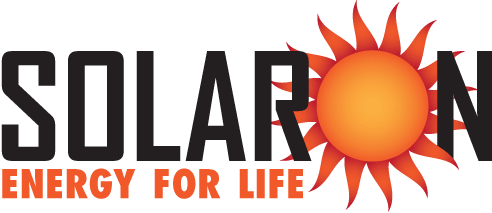
Previously, we discussed the history and makeup of photovoltaic (PV) cells. We also discussed how these solar cells work. Here’s a quick summary: when light photons hit a PV cell, electrons inside get knocked loose from constituent atoms. By attaching conductors to the positive and negative sides of the cell, an electrical circuit is formed. The released electrons then generate electricity as they flow through that circuit. But a solar panel is more than just one single cell. Let’s talk about solar panels and how they are put together.
Solar Cells and Solar Panels
A typical solar cell is about 6 inches long by 6 inches wide, with variations depending on the company of manufacture. (Solaron only uses SunPower solar panels. Their cell size depends on the model of panel purchased.) When a series of solar cells are connected in the same circuit and housed in a single unit, it’s called a solar panel. So, while a solar panel looks like a single item, it’s in fact a collection or aggregation of solar cells. Likewise, when you look at the roof of a home with PV installed, you’re not seeing a single solar panel, but a group of connected solar panels. It’s this array of solar panels, each housing an array of solar cells, that provides enough electricity to run your home.
As mentioned before, companies manufacture solar cells and panels differently, so it stands to reason that some panels are better than others. Solaron’s SunPower products are recognized as being of the highest quality in the industry. Their panels are made with higher quality materials. So not only do they resist corroding and cracking, but they generate electricity at a higher efficiency than their competitors. For years, SunPower has provided consumers with a technological advantage over the competition.
Considerations with Solar Panels
An average solar panel contains enough PV cells to make about 250 watts of power at peak production. SunPower solar panels tend to produce even more, over 300 watts being standard and the A-Series actually reaching 400 watts. Connecting four panels together therefore produces about 1 kilowatt on average, even more in bright sunlight.
One report says that the average California home uses 577 kilowatts of electricity per month. Obviously, your usage will fall somewhat above or below that average number. Several factors come into play when determining how much electricity you really use, and the proper number of solar panels your home requires. Some of these factors include:
- Size of roof and panels
- Position of panels
- Materials being used
- Amount and duration of sunshine, though different seasons
- Electrical appliances in the home
- Average duration of occupancy (how often you’re home, and for how long)
This list is by no means exhaustive. Other factors include what you want to do with unused, excess power – perhaps store it in a battery bank, or maybe send it back to the grid for a kickback. Are you intending on getting an electric car in the future? Solaron takes all these factors and many more into account when developing the best solar application for your home. Give us a call, or you can schedule a free solar analysis here on our website. Let’s discuss what details are most important to you when it comes to solar cells and solar panels.

